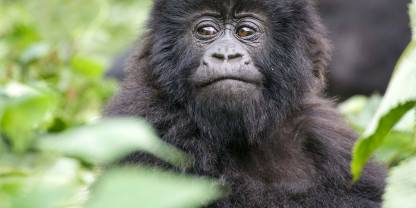Bwindi Impenetrable National Park is Uganda’s main gorilla trekking destination and a Unesco World Heritage Site. It is home to 460 mountain gorillas, which is some 43% of the global population. Roughly 300 of Bwindi’s gorillas, split across more than 25 family groups, have been habituated to tourist visits. The park is also rewarding for bird-watchers, with 23 Albertine Rift endemics listed among the 350 recorded species.

-
Best Time To Go
- June to August and December to February (Gorilla trekking is easiest)
-
High Season
- June to September (Gorilla permits are scarce)
-
Size
- 321km² / 124mi²
-
Altitude
-
1,300-2,462m /4,265-8,077ft
 View Photos
View Photos
 View Photos
+24
Photos
View Photos
+24
Photos
 Open Map
Open Map
Pros & Cons
- Excellent gorilla trekking with almost guaranteed sightings
- Superb bird watching available with knowledgeable guides
- Unspoiled rainforest
- Community projects including village visits
- The best place in Uganda to see wildlife endemic to the Albertine Rift
- Forest trails and internal roads can become slippery in the rainy season
- Limited availability of gorilla trekking permits in the high season
Wildlife
At least 10 primate species occur in Bwindi, including mountain gorilla, chimpanzee, olive baboon, black-and-white colobus, red-tailed monkey and L’Hoest’s monkey. The only representative of the Big Five is a population of seldom-seen elephants (DNA analysis of spoor indicates they are mostly critically endangered forest elephants). Bushbuck and various forest duikers can sometimes be spotted. Bwindi has very impressive bird and butterfly checklists. Another special is the 30cm/1ft-long Rwenzori three-horned chameleon, a striking Albertine Rift endemic.
More about Bwindi's wildlifeScenery
Bwindi Impenetrable NP protects a scenic series of steep ridges and river valleys covered in the dense rainforest for which it is named. Set on the edge of the Albertine Rift Valley, the park has a wide altitudinal range and contains a mix of montane (mountain) and lowland rainforest. It is also one of the most ancient and pristine forests in East Africa, with a diverse flora that includes 10 tree species that don’t occur anywhere else in Uganda.
Activities
Almost everyone who visits Bwindi goes gorilla trekking. This popular activity departs every morning at 8 AM from four different trekking hubs: Buhoma, Ruhija, Nkuringo and Rushaga. Permit numbers are limited and it is advisable to book as far in advance as possible, especially for the peak seasons of June to August and December to February. Bwindi is also a popular destination with bird-watchers and knowledgeable specialist guides are available. Other forest walks and community visits are offered at the various trekking hubs.
Weather & Climate
It can rain at any time in Bwindi, with the wettest months being March to May and September to November. Pack plenty of wet-weather gear to combat the drizzle. The forest’s mild climate is easier to enjoy in the relatively dry months of June to August and December to February.
More about the weather and climateBest Time To Visit
Gorilla trekking is best when Bwindi’s trails are not so sodden and there is more sunshine (June to August and December to February). Slippery trails and occasional mist make wildlife viewing more challenging during the wetter months.
More about the best time to visit



